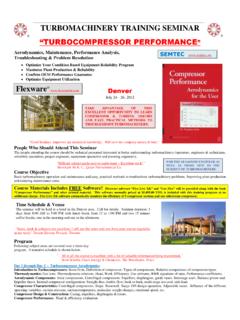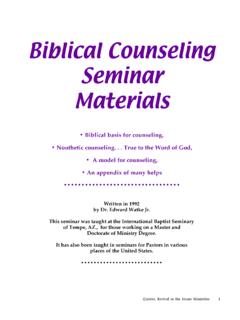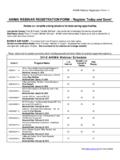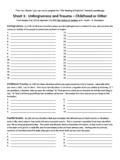Transcription of THE FIVE GOSPElS
1 L THE five GOSPElS The Search for the Authentic Words ofJesus ~ New Translation and Commentary by ROBERT w. FUNK, Roy w. HOOVER, and THE JESUS SEMINAR A POLEBRIDGE PRESS BOOK Macmillan Publishing Company New York Maxwell Macmillan Canada Toronto Maxwell Macmillan International New York Oxford Singapore Sydney j:l , , INTRODUCTION o .. ""~. ~ THE SEARCH FOR THE REAL JESUS: DARWIN, SCOPES, ck ALL THAT The five GOSPElS represents a dramatic exit from windowless studies and the beginning of a new venture for gospel scholarship. Leading scholars-Fellows of the Jesus Seminar-have decided to update and then make the legacy of two hundred years of research and debate a matter of public record. In the aftermath of the controversy over Darwin's The Origin of Species (pub lished in 1859) and the ensuing Scopes 'monkey' trial in 1925, American biblical scholarship retreated into the closet. The fundamentalist mentality generated a climate of inquisition that made honest scholarly judgments dangerous.
2 Numer ous biblical scholars were subjected to heresy trials and suffered the loss of academic posts. They learned it was safer to keep their critical judgments private. However, the intellectual ferment of the century soon reasserted itself in col leges, universities, and seminaries. By the end of World War II, critical scholars again quietly dominated the academic scene from one end of the continent to the other. Critical biblical scholarship was supported, of course, by other university disciplines which wanted to ensure that dogmatic considerations not be per mitted to intrude into scientific and historical research. The fundamentalists were forced. as a. consequence, to found their own Bible colleges and seminaries in order to propagate their point of view. In launching new institutions, the fundamentalists even refused accommodation with the older, established church-related schools that dotted the land. One focal point of the raging controversies was who Jesus was and what he had said.
3 Jesus has always been a controversial figure. In the GOSPElS he is represented as being at odds with his religious environment in matters like fasting and sabbath observance. He seems not to have gotten along with his own family. Even his disciples are pictured as stubborn, dense, and self-serving unable to fathom what he was about. Herod Antipas, in whose territory he ranged as a traveling sage, had him pegged as a troublemaker, much like John 1 Ii the Baptist, and the Romans regarded him as a mild political threat. Yet mu about him remains obscure. We do not even know for sure what language usually spoke-Aramaic or Greek-when instructing his followers. It is r surprising that this enigmatic figure should be at the center of ston of controversy. The contemporary religious controversy, epitomized in the Scopes trial aJ the continuing clamor for creationism as a viable alternative to the theory evolution, turns on whether the worldview reflected in the Bible can be cam, forward into this scientific age and retained as an article of faith.
4 Jesus figur prominently in this debate. The Christ of creed and dogma. who had been firm in place in the Middle Ages, can no longer command. the assent of those wI have seen the heavens through Galileo's telescope. TIle old deities and demo were swept from the skies by that remarkable glass. Copernicus, Kepler, ar Galileo have dismantled the mythological abodes of the gods and Satan. ar bequeathed us secular heavens. The profound change in astronomy was a part of the rise of experiment science, which sought to put all knowledge to the test of close and repeatl observation. At the same time and as part of the same impulse, the advent historical reason meant distinguishing the factual from the fictional in accoun of the past. For biblical interpretation that distinction required scholars to prol the relation between faith and history. In this boiling cauldron the quest of tl historical Jesus was conceived. Historical knowledge became an indispensable part of the modem world basic reality toolkit: Apart from this instrument, the modem inquirer could n, learn the difference between an imagined world and the real world of hurnCl experience.
5 To know the truth about Jesus, the real J,~us, one had to find tt Jesus of history. The refuge offered by the cloistered pJ~ecinets of faith gradual became a battered and beleaguered position. In the Welke of the Enlightenmer the dawn of the Age of Reason, in the seventeenth .md eighteenth centurie biblical scholars rose to the challenge and launched a tumultuous search for tt Jesus behind the Christian fa~ade of the Christ. THE SEVEN pnLARS OF SCHOLARLY WISDOM The question of the historical Jesus was stimulated by the prospect of viewm Jesus through the new lens of historical reason and. rest>.arch rather than thraug the perspective of theology and traditional creedal fonnulations. The search for the Jesus of history began with Hennann Samuel Reiman (1694-1768), a professor of oriental languages in Hamburg, Gennany. A cl~ study of the New Testament GOSPElS convinced Reimarus that what the authoJ of the GOSPElS said about Jesus could be distinguished from what Jesus himse said.
6 It was with this basic distinction between the man Jesus and the Christ ( the creeds that the quest of the historical Jesus began. Most late-twentieth-century Americans do not know that one of our ow sons of the Enlightenment, Thomas Jefferson (1743-1826), scrutinized the gO! pels with a similar intent to separate the real teachings of Jesus, the figure ( THE FM! GOSPElS 2 t much j; lage he is not history, from the encrustations of Christian doctrine. He gathered his findings in The Life and Morals of Jesus ~f Naz~reth, Extracted textually from t~e GOSPElS in stonns Greek, Latin, French, and Englzsh, a little volume that was first publIshed in 1904 nd is still in print. ial and a Meanwhile, back in Germany, the views of Reimarus and his successors were eory of eatly furthered in the monumental Life of Jesus Critically Examined by David carried fr;edrich Strauss (fIrst edition, 1835). Strauss distinguished what he called the figures 'mythical# (defmed by him as anything legendary or supernatural) in the GOSPElS 1 firmly fro~ the historical.))
7 The storm that broke over the 1,400 pages of minute analysis ,se who cost him his first teaching post at the seminary at Tubingen. Critics hounded him iemons up to the time of his death in 1874. ler, and The choice Strauss posed in his assessment of the GOSPElS was between the an, and supematural Jesus-the Christ of faith-and the historical Jesus. Other scholars in the Gennan tradition developed a safer, but no less cruciaL contrast between imental the Jesus of the synoptic GOSPElS -Matthew, Mark, Luke-and the Jesus of the epeated gospel of John. Two pillars of modern biblical criticism were now in place. The ivent of first was the distinction between the historical Jesus, to be uncovered by his lccounts torical excavation, and the Christ of faith encapsulated in the first creeds. The to probe second pillar consisted of recognizing the synoptic GOSPElS as much closer to the st of the historical Jesus than the Fourth gospel which presented a #spiritual# Jesus.
8 By 1900 the third and fourth pillars of modern critical scholarship were also in world's place. The recognition of the gospel of Mark as prior to Matthew and Luke, and ould not the basis for them both, is the third pillar. A fourth pillar was the identification of f human the hypothetical source Q as the explanation for the #double tradition"-the find the material Matthew and Luke have in common beyond their dependence on Mark. radually Both of these pillars will be discussed below. :enment, The tragic and heroic story of those who endeavored to break the church's enturies, stranglehold over learning has been chronicled by Albert Schweitzer in his h for the famous The Quest of the Historical Jesus (1906). Schweitzer himself contributed to that revolt in a major way, following the breakthrough of Johannes Weiss in his Jesus' Proclamation of the Kingdom of God (1892). For Weiss and Schweitzer, the basic decision that had to be made about Jesus was whether he thought the age was about to end in a cataclysmic event, known as the "eschaton" (Greek for the "last evenn, or whether he took a longer view of things.)
9 Weiss and Schweitzer viewing opted for an eschatological Jesus. Consequently, Schweitzer saw Jesus' ethic as through only an "interim ethic (a way of life good only for the brief period before the cataclysmic end, the eschaton). As such he found it no longer relevant or valid. ~eimaros Acting on his own conclusion, in 1913 Schweitzer abandoned a brilliant career in . A close theology, turned to medicine, and went out to Africa where he founded the ~ authors famous hospital at Lambarene out of respect for all forms of life. s himself The eschatological Jesus reigned supreme among gospel scholars from the Christ of time of Weiss and Schweitzer to the end of World War II. Slowly but surely the evidence began to erode that view, which, after all, had been prompted by the our own revolt, towards the close of the nineteenth century, against the optimistic theol i the gos ogy of progress that then prevailed. Meanwhile, neo-orthodoxy under the tute.
10 Figure of lage of Karl Barth and Rudolf Bultmann suppressed any real interest in the historical Jesus for the better part of five decades (1920-1970). Barth and Bult-INTRODUCTION 3 l i mann dismissed the quest of the historical Jesus as an illegitimate attempt to secure a factual basis for faith-an attempt to 'prove' Christian claims made on behalf of Jesus. Even today historical studies of Christian origins still labor under that theological interdiction. The creation of the Jesus Seminar coincides with the reemergence of interest in the Jesus of history, which was made possible by the wholesale shift of biblical scholarship away from its earlier academic home in the church, seminaries, and isolated theological enclaves. While biblical scholarship has not lost its interest in and concern for the Jewish and Christian traditions, it has finally won its libertY. As that interest came back to life in the 1970s and 1980s, scholars we;e surprised to learn that they no longer labored under the tyranny of either neo orthodoxy or an eschatological Jesus.







